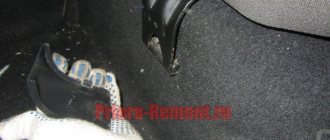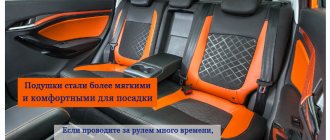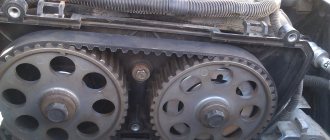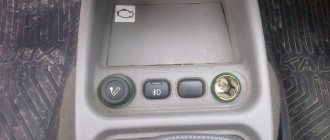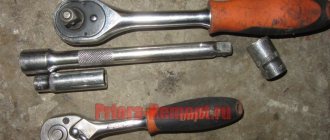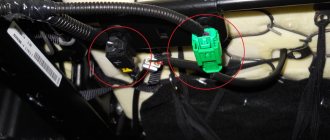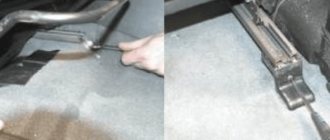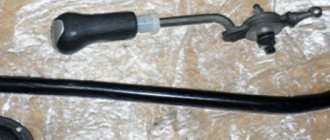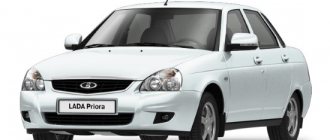Each motorist chooses a car based on the requirements for the vehicle. Those who are guided by practical considerations immediately evaluate the characteristics and parameters of the car, finding out whether it is suitable or not for performing certain tasks other than moving from one point to another. For many, the volume of the luggage compartment and the ability to transform the seats play a big role, which allows you to transport large loads or, if necessary, organize a sleeping place. If you have a spacious SUV or minivan available for out-of-town trips, there are no problems with providing overnight accommodation or transporting things. The transformation capabilities and large usable volume of the interiors of such vehicles provide comfortable accommodation for all passengers and luggage.
Methods of how to properly fold and unfold car seats
However, even if you have the most ordinary compact passenger car, using its functionality, in which case you can also have a pretty good place to rest or place a large cargo. As a rule, the rear seats can recline; almost every modern car offers this feature (although there are exceptions). So, by folding the rear row car seats, you can significantly expand the luggage compartment; it is advisable that they be folded at the same level with the trunk floor, then you can get a single space for cargo or a comfortable overnight stay in the car. Many cars require folding the rear seats in a 60/40 or 50/50 ratio, but there are also those in which this process is performed in 40/20/40 ratios. A more practical implementation of transforming the cabin space is the ability to move the seats of the last row forward, thereby increasing the volume of the cargo compartment without the need for folding. On some models, rear car seats
also recline back, forming a kind of bed, although the best option would still be to organize a seating area in the combined space of the spacious luggage compartment and part of the cabin.
We understand car seats in detail
Along with the steering wheel, seats are the main channel of tactile communication with the car. This is also an important design element. Their role in the perception of many consumer properties of a car is significant.
Seats are probably the most underrated part of a car. We love to sit comfortably, but have little idea how they work. If they knew well, they would hardly use such primitive jargon as “furniture” or “chairs.” Sometimes a complex design, an engineering and technological masterpiece, is hidden under the opaque upholstery. Since this is a very expensive and heavy element of the car, much more attention is paid to it in design and production than in advertising or a journalistic test drive report.
Seating, which occupies a significant part of the interior, is extremely important for designers. And for the driver, the seat is the main channel of physical communication with the car: a third of the surface of the body comes into contact with it. European studies show that the average car driver spends about 22 thousand hours in a car during his life. And although very bad seats are rare today, about 75% of drivers complain of back problems to one degree or another. Plus neck pain, circulatory problems, premature fatigue... The resulting loss of concentration is the cause of a third of serious road accidents in Europe. And you say “chairs”.
Although it all started with furniture technologies. Until the beginning of the 20th century, self-running carriages were equipped with spring seats a la a grandmother’s sofa: a set of twisted metal springs was covered with leather with a small soft lining. Since the 1900s, this particular layer has been improved, using natural fibers from animal wool to coconut threads, including rubberized ones. In the 1930s, foam appeared, first latex. It made the seats cheaper compared to spring ones. Since the 1960s, even more affordable polyurethane foam with various derivatives came to the auto industry.
Even 30 years ago, the best car seats were thought to combine a spring frame and a molded foam shell, but economic considerations eliminated the "couch" design by the early 1990s. The springs in the chairs remain today, but have been simplified to an S-shaped wire, as an unobtrusive support for the foam.
In any case, the basis is a frame made of metal or composites. Its strength has increased many times in recent decades, primarily due to stricter passive safety requirements. At a minimum, seat belt buckles and even inflatable cushions are now attached to the seats, and the seats themselves are supposed to be tested for strength according to a variety of parameters. These standards, as well as the development of a scientific approach to the design of standard seats, almost killed the tuning market. Even the famous company Recaro, which started with them, has not been producing civilian car seats itself for about ten years, only “trading the name” to the side.
It is customary to professionally evaluate seats twice. The primary perception is static, during literally the first 10–15 seconds after you find yourself in the chair, like a buyer in a car dealership. Doesn't it interfere with the planting process? How tough? Isn't it crowding? Does it hold up well? And most importantly, how the reactive forces from the pressure of the human body on the upholstery are distributed. Simply put, what is the initial relief or “profile” of the seat that we often mention in tests?
Then, during a trip of at least an hour or two, an idea of dynamic comfort is formed. Added to all of these factors - and their perception in motion may change - is how the seat absorbs a wide range of vibrations. After all, it is not only the suspension that is responsible for the smooth ride of a car, but the triumvirate of tires, chassis and seats.
From a scientific point of view, this means that the frame, elastic elements, foam, together and separately, must avoid resonances in the most unpleasant frequency range from four to eight hertz. Resonances at frequencies from 0.1 to 0.6 Hz cause motion sickness - remember the soothing back seat of your grandfather's Volga? The abandonment of frames on coiled springs has made life much easier for people with weak vestibular apparatus. The natural frequencies of modern seats are much higher. They should not be made too rigid so as not to transmit vibrations.
How to make the perfect seat? Scientific research on this topic began only in the 1940s, and it took two or three decades before the results had a noticeable impact on mass-produced products, and not everywhere. But now there is no shortage of data, and no one seems to be working on a whim or at random. Numerous studies even sometimes contradict each other. Including the most important thing - how the load from the body should be distributed across the seat.
A minority of scientists believe that it is enough to make the seat evenly soft, as, for example, in old French cars. Most believe that stiffness should vary because different parts of the body bear the load differently. You can reduce the pressure on vulnerable tissues by making the seat tighter where it contacts the hardiest parts of the body. These are the buttocks under the so-called ischial tuberosities and the lumbar region on the back.
The angle between the pillow and the backrest is selected so that the person does not “slide” on the pillow, because then tissue shift will be added to the tension from compression in the lower part of the body. At the same time, riders should be able to change their position on a long journey without significantly changing the pressure map. In the most comfortable position for a person, each joint is approximately in the middle of its range of rotation. All calculations are carried out relative to the center of the hip joint, the so-called H point (from hip-point, but some engineers use the R index).
Source
Removal and installation
Just like with the front ones, there are many situations where it may be necessary to remove the seats. The most common thing besides repairs is the installation of covers. To perform this procedure, the following procedure is required:
- You need to empty the trunk, pull out the rubber mat, then unscrew the six nuts holding the backrests.
- The backrests can be removed from the seat and pulled out through the side doors.
- The seat cushion is raised enough so that you can unscrew the bolts securing it to the body.
- Assembly proceeds in reverse order.
Rear seat removal process
It may be necessary to dismantle the rear seats for several reasons, such as the need to replace some parts, modernize them, install covers, or reupholster the seats in general.
Step-by-step removal procedure
- Open the trunk door and remove the rubber mat.
Trunk mat and trunk itself on Niva Chevrolet.
How to remove the back seat
Sometimes it is also necessary to remove the seat from the car. The rear seat is removed for various reasons, for example, to accommodate non-standard cargo or for the purpose of replacement, etc. To carry out the procedure, it is not necessary to resort to the help of specialists; the motorist can handle this on his own, armed with a wrench and a screwdriver. Removing the rear seat is carried out as follows:
- First, you should remove the rubberized plugs from the seat cushion mounting posts that cover the fastening nuts. By unscrewing them, we fold them so that they do not get lost during the dismantling process and do not get tangled with other elements.
- Removing the pillow should be done very carefully. We lift its upper edge and, moving the chair forward a little, remove the pillow, disconnecting it from the fixing elements that hold the back part.
- We remove the spare tire bracket (in the luggage compartment), bend it and pull out the fastening plates connecting the floor to the trunk mat. To get to the seat backrests, you will need to remove the front cargo compartment trim.
- In the trunk we find two nuts that secure the right and left parts of the backrests, unscrew them and set them aside so as not to lose them.
- We tilt the back of the rear seat so that the fastening bolts come out of their holes, then remove the back of the seat, freeing the brackets from the brackets. We take the back out of the car.
- Rotate the armrests 45°, unscrew the fastening bolts and carefully remove the armrests.
- Now, getting rid of the fixing elements, we dismantle the head restraints.
Installation of the seats is carried out in the reverse order, with each mounting bolt returning to its original position. Despite the fact that the seats in each car are implemented differently, the principle of their dismantling is similar.
Folding seats: interior transformation
When you choose a car, the question of utilitarian benefits is usually not so much of a concern.
The owner of a passenger car does not often have to transport large cargo, and a large trunk is increasingly perceived not as an urgent necessity, but as simply a pleasant bonus. Shopping bags or vacation suitcases don't take up much space. There are, of course, people for whom this is a critical moment; they either buy non-passenger cars or choose cars only based on this parameter. Such car owners are actually a minority. The rhythm of city life does not require such tasks for the average driver. But what to do if you still need to transport, say, a refrigerator? To transport large cargo in the car, you can fold the rear seats
note
There are a few simple recommendations when transporting large cargo on the folded rear seat. Most of them are dictated by ordinary common sense. For example, if the cargo you are transporting is unevenly heavy, then try to place the heaviest part of it in the trunk. The improvised stiffener, which we wrote about above, certainly helps, but it does not guarantee 100% safety of the seats. If the load is heavy at any point, try to position it so that the load falls more on the surface of the trunk floor. If possible, the load should be secured. For this you can use, for example, belts or blankets. Well, or support it with another, smaller load.
Manufacturers often promise a “flat floor” when the seats are folded down. Some, of course, keep their promise. But for many, the floor will not be completely level. Therefore, again, if possible, place unstable cargo (buckets with liquid, boxes with bulk mixtures, etc.) so that it does not have room to move. In general, as we said, these rules are determined only by common sense and are intuitively understandable.
Purpose and design of the rear seats
Rear seats view from the trunk.
The voluminous design in the form of a wide cushion for seating and a backrest with soft filling provides all passengers with a comfortable position in it.
These elements are very rigidly fixed inside the cabin, and the profile, rigid frame on the back is not only designed to increase elasticity, but also to hold the padding inside it. The backrest can be folded, increasing the space in the rear of the car.
Headrests
The rear seats are equipped with another element that is responsible for the comfortable position of passengers in the cabin - head restraints . There are two of them in the back seat, and they are installed on the left and right sides, which allows them not to interfere with the driver’s view in the rearview mirror.
To make it easier to unfold or dismantle the chair, you must first remove the headrests, adjusting their position with special pins.
This is what the headrests on a Niva Chevrolet look like.
How to fold the rear seats correctly
If the functionality of the car interior allows the seats of the last row to fold out so that passengers can sit comfortably to rest, this can be done using the adjustment lever provided by the design. We perform the following actions:
- Before reclining the third (if equipped) and rear seat, the front seats should be moved as far forward as possible.
- Remove the headrest from the third chair and insert it into the storage holes. Then, when you press the lever, fold the backrest forward.
- Pull the lever up and tilt the back of the car seat back.
- We remove the headrests from the back seat, also insert them into the corresponding holes in the bottom of the sofa cushion, then lower the side of the backrest, while lifting the locking lever up.
- Move the rear seat all the way forward.
- Raise the lever and fix the chair.
- We pull the lever, reclining the backrest completely and unfolding the rear seat. When doing this, lower the armrests to avoid damaging them. In some cases, it may be necessary to remove the armrests for maximum passenger comfort.
